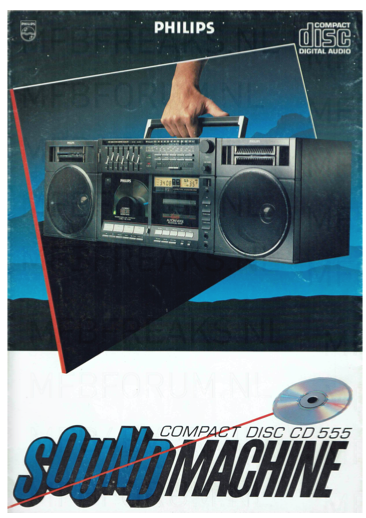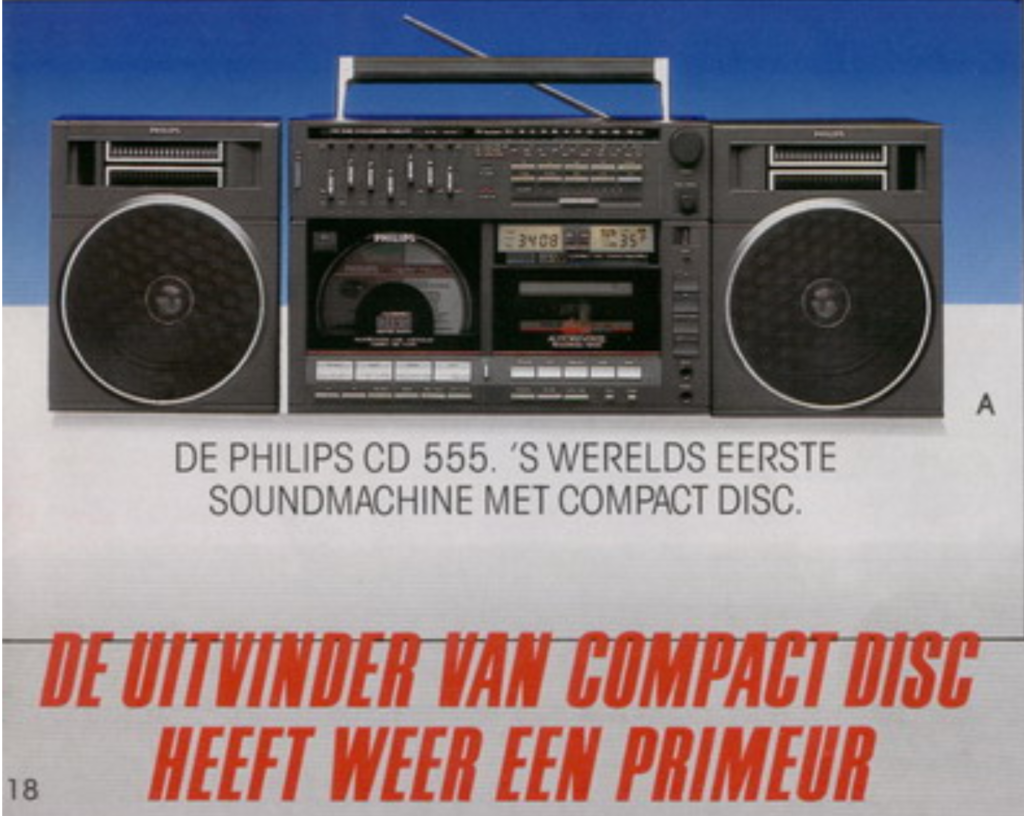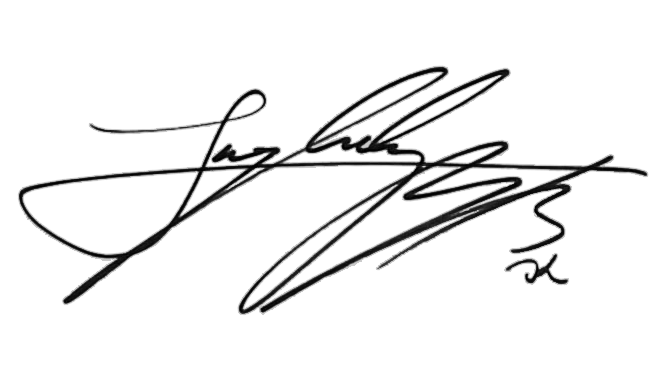About the 70CD555
- Stereo combination of Compact Disc (player), radio (tuner), amplifier and cassette deck
- Microprocessor-controlled programmable Compact Disc player with pause, repeat, next track and previous track
- 2x25W (Music Power) output
- FM/LW/MW/SW radio (tuner) with SW fine tuning
- Microprocessor-controlled programmable auto-reverse cassette deck with facilities for all tape types and ‘logic control’ operation
- Handle for transporting the combination to any desired location
- Multifunctional LCD display(s) for Compact Disc (player) and cassette deck
- 5-band graphic equalizer
- Microphone input with mixing and public address facilities
- Headphone socket
- Fully complementary loudspeakers
- Rechargeable battery pack EM5555 (optional)
- Dimensions including loudspeakers (hxwxd): 200 x 600 x 200



Details & History
Produced in 1985 the CD555 was the very first Sound Machine introducing a portable CD-Player (1986 Philips, Flyer and Philips catalogue scan on the left side). Philips was using the same mechanism and decoders as in the Philips CD150 – which by the way is the best donor for getting spare parts. The CD format was quite new and the Sound Machine contains the second series of CD technology after the famous CD-Players of the series 10x. The CDM2 drive was a weight and cost reduced version of the CDM1 mechanism. It is from a good quality (although some swear on the CDM1) and very reliable considering its age.
In 1985 microprocessor controlled cassette decks with soft touch buttons where rare and if existing a feature only of high end devices. Philips intuition was to have the same touch and feel when dealing with the cassette deck as for their newly invented CD-Players (1986 Philips, Flyer). The cassette mechanics are SER1 and also used for the Philips FC156 and FC455 (donor!). Some variants exists with less functions like missing auto-reverse (FC15x or some Blaupunkt and Grundig variants).
Music search and programming capabilities were a new and amazing feature back those days and is exclusive for the CD555. Furthermore, Dolby-B for noise reduction was included. Several modes for direct recording of a CD are included, inclusive a mode to insert four seconds silence between the tracks to be able to use the music search for the recorded cassette.
The 4-band tuner provided access to all available bands in the eighties. The amplifier with 2×25 Watt with 2 way speakers made of wood produces a gorgeous sound and still astonish the audience.
Summarising the efforts Philips made, it seems that they tried to create a kind of example of a Boombox with very high quality. A quality which some sources point out that this level of quality was never seen at Philips again afterwards. Everything is well equipped and constructed. Only best components of its time are included. The design might be more traditional as it is not as offensive as other Boomboxes. Same is valid for the chosen colour – it is neither black or silver as its competitors.
The drawback of the design, the quality and all the features are of course the costs. The price of this Sound Machine was far ahead and cost more than twice of other Boomboxes (of course without CD-Player). There is no number available about sold quantities, but very soon afterwards the three piecer Sound Machine Philips D8854 got introduced.
While offering similar features as the CD555 the D8854 was produced with the price in mind. The CD mechanism CDM2 was the same but the decoders were reduced to two chips compared to seven in the CD555. The D8854 contains a SAA7210 and TDA1541/N3 DAC instead of SAA7000, SAA7010, SAA7020, SAA7030, a memory chip, D-FlipFlop and two TDA1540P DACs. The CDM2 controller panel was more directly connected to the main panel and cannot be used as a donor. Simplier, manual tape mechanics which are not controlled by a microcontroller were used to reduce the costs. As a direct result the D8854 does not offer the same feeling neither can its sound quality compared (Source: Compare the service manuals).
The used 14Bit TDA1541 DACs are still well accepted by audiophile users. Interesting is the story behind the usage of a 14Bit DAC whilst all others of this time where using 16Bit DACs. In a short – Philips designed the Audio CD with 14Bit and when Sony joined the project they changed to 16Bit. They also agreed on 12cm disc size. “Following the pioneering work of Philips on an optical video player in the early 70’s, a project was started in 1974 within Philips and its Research laboratories to develop a digital optical audio disk with error correction code. Parallel work on digital optical audio recording was done in a number of companies and Sony first publicly demonstrated an optical digital audio disc at the 1977 Audio Fair. On 8 March 1979, Philips demonstrated for the international press a 11.5 cm Optical Disk and a Compact Disc Audio Player. The demonstration showed that it is possible by using digital optical recording and playback to reproduce audio signals with superb stereo quality. Through the co-operation with Sony the final diameter was 12 cm and the initially proposed resolution (accuracy) of 14 bits was increased to 16 bits. With this concept Philips and Sony took the first step in setting a worldwide standard.” (Philips, The history of the CD – The beginning)
“Als Wortlänge für die PCM-Signale sind 14 Bit vorgesehen. Das ändert sich, nachdem Sony ins Spiel kommt…” “Europa und Japan geben Gas, einigen sich auf zwölf Zentimeter Disc-Durchmesser, knapp 75 Minuten Spielzeit, 16 Bit PCM-Wortlänge, Cross-interleaved Reed-Solomon Code (CIRC) als Fehlerkorrektur und die EFM-Leitungskodierung.” (2019, heise, 40 Jahre CD: Die silberne Klang-Revolution)
An article not only described that Philips was using their 14Bit design but also gives much more details and an interesting technical explanation “Philips had found a clever way of using its existing 14-bit DAC to meet the 16-bit CD standard. In its 14-bit, 4-times oversampling system, a digital filter stage prior to the DAC created three extra samples for each of the original samples. When these extra samples were integrated in the DAC, at four times the original rate, the result was a resolution equal to 16-bit. As far as the DAC was concerned, the sampling frequency was now 176.4kHz instead of 44.1kHz. This in turn meant that the unwanted frequencies contained in the DAC’s output were much higher too. Now, instead of a steep ‘brickwall’ filter acting at just above 20kHz, and causing problems in the audio band below, the Philips player’s audio output stage needed only a gentle, innocuous analogue filter.
This gave the early Philips players a sonic advantage over ‘16-bit linear’ rivals. Although 14-bit 4-times oversampling was born of necessity, it sounded smoother and less fatiguing. Also contributing to the CD100’s superior performance was Philips’ swing-arm mechanism, as opposed to the linear, radially-sliding ‘sled’ types used by the Japanese makers.” (2011, hifi-news, Philips CD100 (Vintage))
Although the SoundMachine weights 10kg it needs an optional battery pack to become “portable”. I have done a lot of research but until now I was not successful to find any information about the 12V rechargeable battery pack EM5555. If anyone owns this battery pack or has information about it I would be keen to get an eye on it and to do some reverse engineering to rebuilt it. Would love if someone would contact me about it.
Costs were and are still a huge topic and at the end of the eighties the European market got flooded with Korean made products with low prices which sometimes came along a questionable sound quality.
The CD555 was a Soundmachine of its own – high quality, excellent sound and features way ahead of its time. Unfortunately it is a rare find and if it could be found the speakers might be missing. However, if you even get the chance to buy one then get it! Sometimes the problems can get solved easily. Exchanging the old capacitors might cost around 80€ and is absolutely necessary. Disassembling the device might be frustrating, especially the first time, because of its complexity but after some time you will find it easy – have a look at my teardown video to get some ideas.
There is also a workaround and modification for the faulty firmware of the cassette deck available (soon on the website available). Other modification which I show soon is how to add a bluetooth module or exchange the OpAmps.
There is an ongoing discussion if Sony’s CFD-5 was the first Boombox with a CD-Player or not. However, until now I was not able to find an official document from Sony. However, that is not so important, the different design of Sony and Philips CD-Player from 1985 is much more interesting – the Philips CDM devices with swing arm are well known – I do not have the Sony but I found some pictures of the CDF-5 and the it gets mentioned that it look like the portable D-50 “After all it seems to be Manma D-50. Since the D-50 is a portable machine, parts such as screws are also small.” (SONY CFD-5 (1985) Disassembly) Easy to spot the differences of Sony’s SMD technology and Philips with ICs in DIP cases.

About Me
After elementary school I studied electronics but loved to write games and demos for the Commodore 64. Hence, later on I became a software developer but still highly interested into electronics and micro-controller units. Realised home automation and pool control with Arduinos. I have a lot of ideas pending and only missing the time to realise them.
Sports
An important part in my life are sports. It helps me to get my head free and gather new ideas
- Mountain Biking
- Road Race Biking
- Catamaran Sailing
- White Water Kayaking
- Sea-Kayaking
Education
- Marticulation in Electronics
- Master of Science in Engineering (Vienna)
- Master of Science in Business Information (Moscow)
- Master of Business Administration (Scotland)

